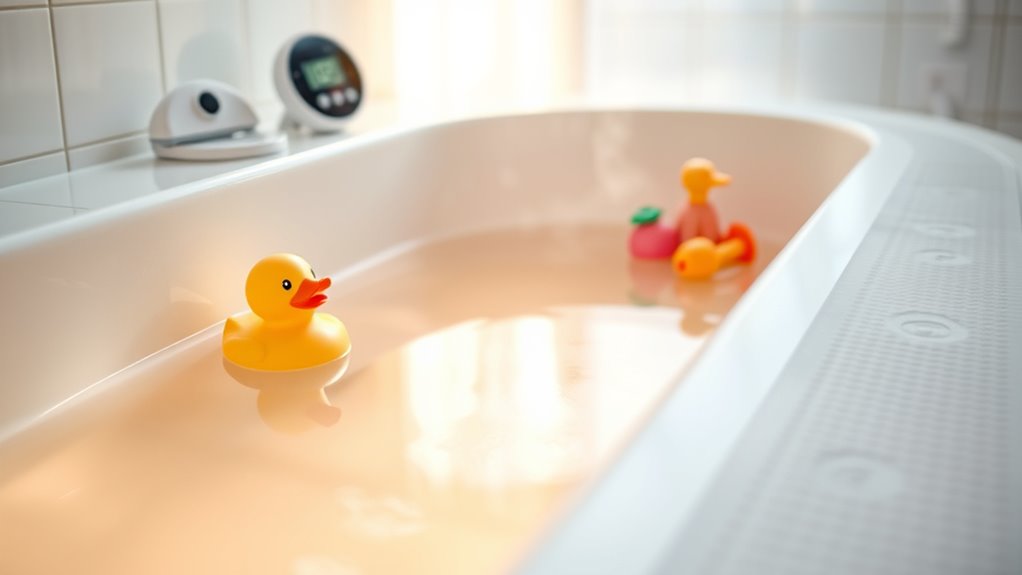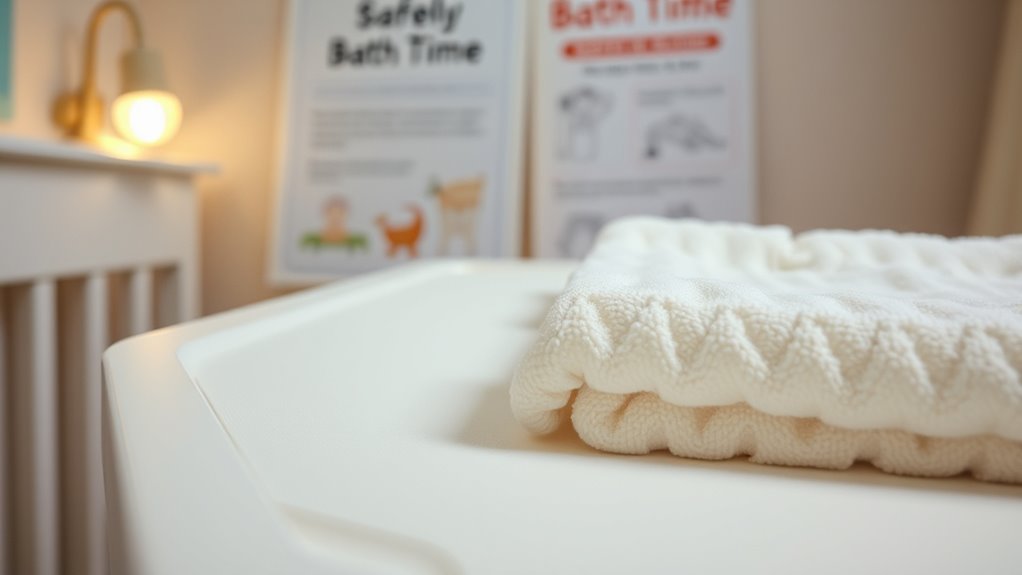As a new parent, you might overlook vital bath safety rules like always testing water temperature before placing your child in the tub and keeping a thermometer nearby. You should also be cautious about slippery surfaces by using non-slip mats and never leave your child unattended, even for a moment. Proper safety equipment and a clutter-free environment are essential to prevent accidents. Stay vigilant, and you’ll discover more ways to make bath time safer for your little one.
Key Takeaways
- Always test water temperature with your wrist or elbow before placing your child in the tub.
- Never leave your child unattended in the bath, even for a moment.
- Use non-slip mats inside the tub and bathroom floor to prevent slips and falls.
- Regularly check and properly install safety equipment like bath seats or support rings.
- Remove sharp or hard objects from the bathing area to prevent injury if the child slips.

Are you confident your child’s bath time is completely safe? Many new parents focus on keeping their little ones warm or preventing drowning, but there’s more to safety than just that. One of the most overlooked aspects is managing water temperature and slip hazards. Making certain the water is at a safe temperature is vital because babies and young children have sensitive skin and can easily get burned if the water is too hot. You should always test the water with your wrist or elbow before placing your child in the tub. The ideal water temperature is around 100°F (37.8°C), which feels warm but not scalding. Never rely solely on the tap’s temperature setting, as it can vary or malfunction. Consider installing a thermometer on your faucet or in the tub to double-check the water temperature every time. It’s also wise to fill the tub ahead of time so you can verify the temperature before your child enters, allowing you to make adjustments if needed. Regularly monitoring air quality and safety measures can help prevent accidents caused by technology malfunctions, which is especially important if you’re using smart devices to control water temperature. Slip hazards are another vital concern that often gets overlooked. Wet surfaces are inherently dangerous, and even a small amount of soap or water on the tub’s surface can make it slippery. To minimize the risk of slips and falls, always use a non-slip mat inside the tub and on the bathroom floor if necessary. Keep a firm grip on your child during the entire bath to prevent accidental slips, especially when lifting them in or out of the water. It’s also beneficial to be aware of Glycolic Acid benefits, as some skincare products with exfoliating agents can irritate sensitive skin if accidentally splashed or exposed during bath time. Additionally, bath safety equipment such as bath seats or support rings should be used properly and inspected regularly for stability. It’s important to remove any sharp or hard objects from the tub area, such as razors or glass bottles, which can cause injury if your child falls or slips. Furthermore, understanding home safety practices can help create a safer environment for your child’s bath time. Additionally, ensure the bathroom floor is dry and free of water spills to prevent you from slipping while handling your child. Never leave your child unattended in the tub, even for a moment, as accidents can happen quickly.
Frequently Asked Questions
When Is the Safest Time to Bathe a Newborn?
You should bathe your newborn when they’re alert and calm, usually after feeding and when they’re not too sleepy or hungry. This helps keep them comfortable and safe. Avoid bathing immediately after infant sleep or feeding routines, as they might be more irritable or sleepy. Timing baths between naps and feedings guarantees your baby stays relaxed, making bath time safer and more enjoyable for both of you.
How Can I Prevent My Baby From Slipping During Bath Time?
Think of bath time as a delicate dance—you need balance and awareness. To prevent your baby from slipping, always use a non-slip mat in the tub and never leave them unattended. Keep a firm hold and stay within arm’s reach, providing constant supervision. This way, you guarantee a safe, smooth experience, much like a careful choreographer guiding their young star through a performance. Your vigilance keeps bath time safe and enjoyable.
What Temperature Should the Water Be for a Baby’s Bath?
You should aim for a water temperature around 98.6°F (37°C) for your baby’s bath. Use a thermometer to check, ensuring it’s warm but not hot, to promote bath safety. Always test the water with your wrist or elbow before placing your baby in, as their skin is sensitive. Keeping the temperature consistent prevents burns and keeps bath time safe, making it a comfortable experience for your little one.
Are There Specific Bath Products Recommended for Sensitive Baby Skin?
You should choose gentle cleansers and hypoallergenic lotions for your baby’s bath, especially if they have sensitive skin. These products are formulated to be mild and free from irritants, reducing the risk of allergic reactions or dryness. Always read labels carefully, and opt for those specifically designed for delicate skin. Using gentle, hypoallergenic products helps keep your baby’s skin healthy, soft, and protected during bath time.
How Often Should I Bathe My Newborn to Ensure Safety?
Every moment with your newborn is precious, so you might wonder how often to bathe them for gentle cleansing and skin hydration. Typically, bathing 2-3 times a week is enough, as daily baths can dry out delicate skin. Focus on gentle cleansing during sponge baths on non-bath days, and always make certain the water is warm. This routine protects your baby’s skin while keeping them fresh and comfortable.
Conclusion
Now that you know these overlooked bath time safety rules, imagine one moment where a simple mistake could turn into a disaster. Are you prepared to act quickly if the unexpected happens? Keep these precautions in mind, stay alert, and never let your guard down. Because when it comes to your little one’s safety, one small oversight could lead to a tense, heart-pounding situation. Stay vigilant—your child’s safety depends on it.









